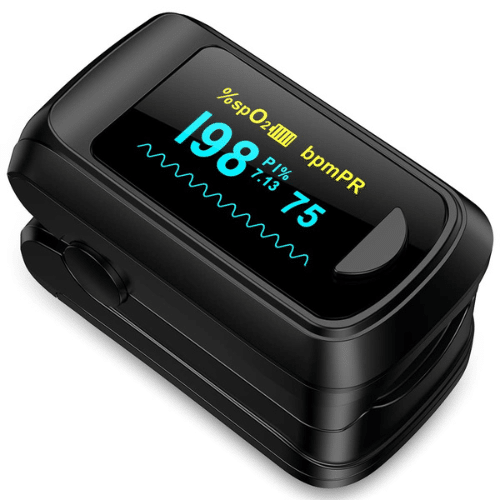This portable pulse oximeter's SpO2 monitoring capabilities are quite capable. In any circumstance, it can quickly and reliably detect SpO2 and pulse rate. This oximeter is capable of spot checks, continuous monitoring, real-time data replay, and a SpO2 plethysmograph display. The SpO2, PR, Perfusion Index, Pulse Bar, and Waveforms are visible on the high-definition screen. It has a 72-hour data storage capacity and may be used with 127 distinct IDs.
Portable pulse oximeter monitoring SpO2, perfusion index, pulse bar, and wave shapes with an adult, pediatric, or infant probe. Oxygen saturation is measured by clip-on devices called pulse oximeters. The gadget can be fastened to a finger, wrist, foot, or any other location where blood flow can be detected. The body depends on oxygen for the survival of every system and organ. Cells start to malfunction and eventually perish without oxygen. Cell death can result in serious symptoms and, eventually, organ failure.
The lungs filter oxygen before the body distributes it to the organs. The hemoglobin proteins in red blood cells allow the lungs to release oxygen into circulation. The remainder of the body receives oxygen from these proteins. As measured by pulse oximetry, the oxygen saturation of hemoglobin proteins is termed. Oxygen saturation typically reflects the amount of oxygen getting to the organs.
Features
- Suitable for detection at perfusion indices as low as 0.1% in low perfusion situations.
- The design allows for usage in challenging settings, such as those with shock and vibration.
- Automatic rectification of artifacts caused by movement and ambient light
- Sensor errors or disconnections, system problems, and low battery all include audible and visual alarms.
- Monitoring of SpO2, Pulse Rate, and Perfusion Index
- Set the SpO2 and PR alarm thresholds.
- Backlight brightness can be changed from 1 to 7.
- Configure two display modes: Displaying a waveform or data
- Table of SpO2 and PR data
- The storing of 127 patient IDs for 72 hours
- Battery-operated base
Technical Specifications
- A SpO2, pulse rate, and respiratory rate monitor are available for babies, kids, and adults.
- The range of SpO2 detection is 70 to 100%.
- Resolution for SpO2: 1%.
- For all patients, SpO2 accuracy (in the range of at least 70 to 100%): 2% (no motion, low perfusion), 3% (motion) (infants, children and adults).
- The range for pulse rate detection is 25 to 240 bpm.
- The resolution for pulse rate is one bpm.
- For all patients, the accuracy of the pulse rate is within three bpm (no motion, low perfusion) and five bpm (motion) (infants, children, adults).
- The range of the respiratory rate is 4 to 90 rpm.
- Resolution of respiratory rate: 1 rpm
- In ideal circumstances, respiratory rate accuracy is within one rate per minute
Display
- One second for data display refresh rate.
- %SpO2, pulse rate, respiration rate, signal quality, status messages, and battery state indication are the key parameters on display.
- Age group feedback for patients.
- The display shows both high and normal respiratory rate counts for the age entered.
- SpO2 below 90% is indicated on display (hypoxemia per WHO guidelines.).
Electrical Characteristics
- Powered by a rechargeable Li-ion battery that cannot be replaced.
- External AC battery charger with local supply voltage and plug type.
- immunity to defibrillator discharges.
- Suitable for operation on a battery and, if connected and recharged, on a mains power supply.
- When recharging or during a mains power outage, an automatic switch occurs between battery and mains powered modes.
- Which power source is currently in use is displayed.
- Twelve hours of running duration on a single charge (24h at lowest screen brightness and beep tone turned off).
- Automatic power-off following a period of inactivity.
Product Importance
- The long-term measurement of oxygen saturation
- Providing peace of mind to those with ongoing respiratory or cardiovascular disorders by warning of dangerously low oxygen levels, especially in neonates
- Determining whether additional oxygen is necessary
- Detecting hazardous side effects in patients taking medications that influence respiration or oxygen saturation by monitoring oxygen saturation levels in anesthetized patients.
Summary
The handheld pulse oximeter is helpful for those with illnesses that impact oxygen saturation. If a person has severe snoring or suspected sleep apnea, a sleep specialist may advise using this pulse oximeter to track their nocturnal oxygen saturation level. The effectiveness of respiratory therapies like oxygen therapy and ventilators can also be evaluated using pulse oximetry.
Some medics recommend that a patient should use an oximeter when determining whether physical activity is safe for patients with cardiovascular or respiratory conditions. Pulse oximetry is another tool a doctor may use during a stress test. For very vulnerable patients, some hospitals also utilize pulse oximeters. For instance, infants in critical care units may wear pulse oximeters, which can notify staff of a decline in oxygen saturation.
